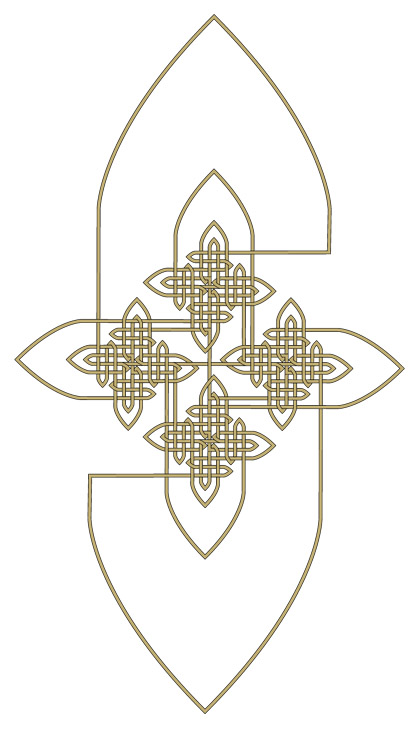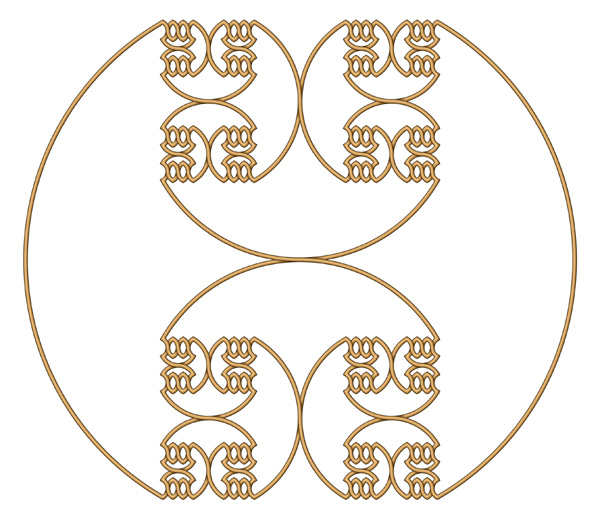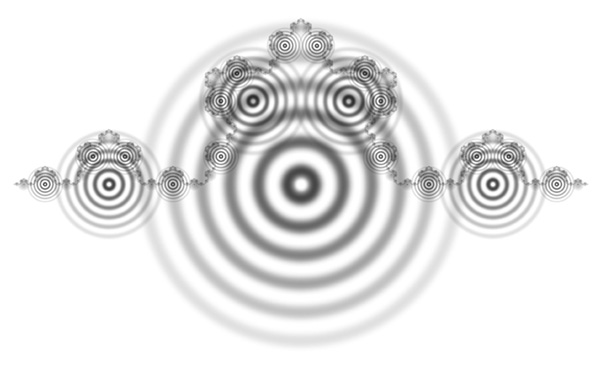Robert Fathauer |
"Twice Iterated Knot No. 1"
Digital print, 9" x 15",
2008.

The starting point for this knot is a nine-crossing knot that has been
carefully arranged to allow seamless iteration. Four regions of this
starting knot are replaced with a scaled-down copy of the full starting
knot, incorporated in such a way that the iterated knot is still
unicursal. These same four regions are then replaced with a scaled-down
copy of the iterated knot, resulting in a complex knot possessing self
similarity.
"127-crossing Self-similar Knot"
Digital print,
12" x 10",
2009.

The starting point for this knot is a three-crossing knot that has been
carefully arranged to allow seamless iteration. The strands, smoothly
varying for the most part, also contain sharp corners, a design esthetic
borrowed from Celtic knots. Two of the three crossings in the starting
knot are replaced with a scaled-down copy of the group of three
crossings, incorporated in such a way that the iterated knot is still
unicursal. The scaling factor is the inverse of the square root of 3,
and there is a 90 degree rotation with each iteration. Five iterations
are performed in similar fashion, resulting in a complex knot possessing
self similarity.
"Fractal Ripples No. 1"
Digital print,
15" x 10", 2009.

The starting point for this graphically-constructed fractal is a group
of concentric rings (a "ripple pattern"), with each larger ring being
increasingly transparent. This ripple pattern is designed to mimic the
waves that would form around a stone dropped in water. Three half-scale
copies of the ripple pattern are positioned around the starting ripple
pattern. The resulting group of four ripple patterns is then scaled by
half, and three copies are positioned around the starting ripple
pattern. This process is repeated until the new ripple patterns are so
small as to be invisible to the eye at the scale of the print. Dark
areas are created by the overlap of the waves, similar to constructive
interference patterns. The final fractal reveals a skewed Sierpinski
triangle. The print paradoxically presents a collection of straight
lines to the eye, even though it is entirely comprised of circles.
"Fractal Ripples No. 3"
Digital print, 15" x 10", 2009.

The starting point for this graphically-constructed fractal is a group
of concentric rings (a "ripple pattern"), with each larger ring being
increasingly transparent. This ripple pattern is designed to mimic the
waves that would form around a stone dropped in water. Four
one-third-scale copies of the ripple pattern are positioned around the
starting ripple pattern. The positions were intentionally chosen as the
midpoints of the line segments in a Koch Curve construction. The
resulting group of five ripple patterns is then scaled by one third, and
four copies are positioned around the starting ripple pattern. This
process is repeated until the new ripple patterns are so small as to be
invisible to the eye at the scale of the print. Dark areas are created
by the overlap of the waves, similar to constructive interference
patterns. The final fractal reveals a Koch Curve, even though the ripple
patterns are centered in what would be empty spaces in the curve.
Robert Fathauer, Small business owner, puzzle designer, and artist
Tessellations,
Phoenix, Arizona
Robert Fathauer makes limited-edition prints inspired by tiling,
fractals, and knots. He employs mathematics in his art to express his
fascination with certain aspects of our world, such as symmetry,
complexity, chaos, and infinity. His artworks are created on a Macintosh
computer, primarily using the commercial programs FreeHand and Photoshop.